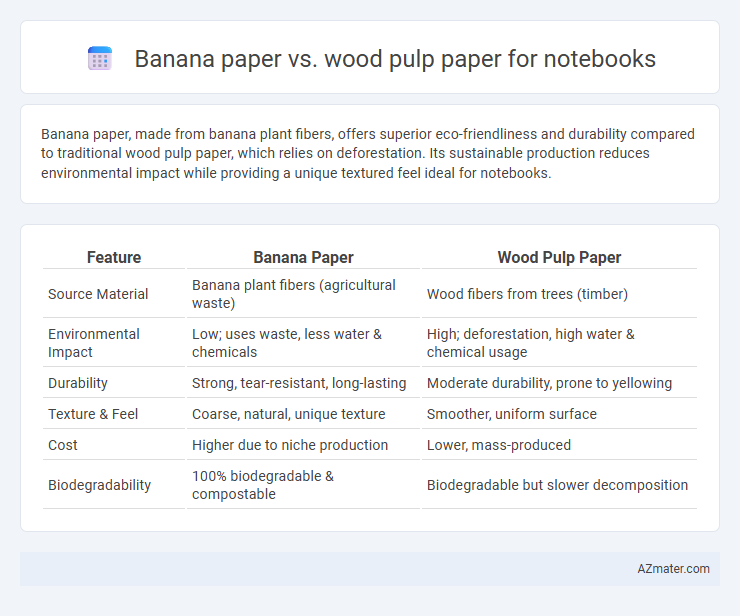Banana paper, made from banana plant fibers, offers superior eco-friendliness and durability compared to traditional wood pulp paper, which relies on deforestation. Its sustainable production reduces environmental impact while providing a unique textured feel ideal for notebooks.
Table of Comparison
| Feature | Banana Paper | Wood Pulp Paper |
|---|---|---|
| Source Material | Banana plant fibers (agricultural waste) | Wood fibers from trees (timber) |
| Environmental Impact | Low; uses waste, less water & chemicals | High; deforestation, high water & chemical usage |
| Durability | Strong, tear-resistant, long-lasting | Moderate durability, prone to yellowing |
| Texture & Feel | Coarse, natural, unique texture | Smoother, uniform surface |
| Cost | Higher due to niche production | Lower, mass-produced |
| Biodegradability | 100% biodegradable & compostable | Biodegradable but slower decomposition |
Introduction to Sustainable Paper Alternatives
Banana paper, made from discarded banana plant fibers, offers a sustainable alternative to traditional wood pulp paper by reducing deforestation and waste. This eco-friendly material provides similar durability and texture, making it ideal for notebooks while lowering environmental impact. Sustainable paper alternatives like banana paper help conserve natural resources and promote circular economy principles in paper production.
What is Banana Paper?
Banana paper is an eco-friendly alternative made from the fibrous waste of banana plants, offering a sustainable option compared to traditional wood pulp paper used in notebooks. Unlike wood pulp paper, which relies on tree harvesting contributing to deforestation, banana paper utilizes agricultural byproducts, reducing environmental impact and promoting waste recycling. This paper boasts a unique texture and durability, making it ideal for eco-conscious consumers seeking sustainable stationery without compromising on quality.
What is Wood Pulp Paper?
Wood pulp paper is made from cellulose fibers derived from trees, primarily softwoods and hardwoods, processed through mechanical and chemical methods to create a versatile and widely used paper material. It offers smooth texture, durability, and cost-effectiveness, making it a popular choice for notebooks and other stationery products. Compared to banana paper, wood pulp paper generally has a higher environmental impact due to deforestation and chemical processing involved in its production.
Environmental Impact Comparison
Banana paper offers a significantly lower environmental impact compared to wood pulp paper, as it utilizes agricultural waste from banana plants, reducing deforestation and resource depletion. The production of banana paper consumes less water and energy, and it generates fewer greenhouse gas emissions than conventional wood pulp processing. Furthermore, banana paper is biodegradable and compostable, supporting sustainable waste management practices while preserving biodiversity by minimizing reliance on timber harvesting.
Production Processes of Banana vs. Wood Pulp Paper
Banana paper production utilizes banana plant fibers, extracted from pseudostems after harvesting fruit, which undergo retting, pulping, and drying with less chemical processing compared to wood pulp paper. Wood pulp paper relies on cutting trees, mechanical or chemical pulping (kraft or sulfite process), bleaching, and refining, involving higher energy consumption and chemical use. The banana paper process is more sustainable, leveraging agricultural waste and reducing deforestation linked to traditional wood pulp production.
Durability and Quality Differences
Banana paper exhibits higher durability than wood pulp paper due to its long fibers that create a stronger, tear-resistant texture ideal for notebooks. The natural fibers in banana paper contribute to a smoother surface and better ink absorption, enhancing writing quality and longevity. Wood pulp paper, made from shorter fibers, tends to tear more easily and may yellow over time, impacting the overall durability and aesthetic appeal of notebooks.
Cost Analysis: Banana Paper vs. Wood Pulp Paper
Banana paper typically costs 20-30% more than wood pulp paper due to higher raw material processing expenses and limited large-scale production. Wood pulp paper benefits from established supply chains and economies of scale, making it more affordable for bulk notebook manufacturing. However, banana paper's eco-friendly advantages often justify the premium for sustainable product lines seeking to reduce environmental impact.
Notebooks: Performance Evaluation
Banana paper notebooks exhibit superior durability and moisture resistance compared to wood pulp paper, enhancing longevity under frequent use. The high fiber strength of banana paper contributes to reduced tearing and better writing surface quality, providing a smooth and consistent texture ideal for various pen types. In terms of sustainability, banana paper notebooks offer eco-friendly advantages with lower environmental impact, making them a preferred choice for environmentally conscious consumers seeking high-performance stationery.
Consumer Perspectives and Market Trends
Banana paper, derived from banana plant fibers, offers a sustainable alternative to traditional wood pulp paper, appealing to environmentally conscious consumers seeking eco-friendly notebook options. Market trends indicate rising demand for biodegradable and renewable materials, with banana paper gaining traction due to its lower carbon footprint and unique texture. Consumer preferences increasingly favor products with transparent sourcing and minimal environmental impact, positioning banana paper notebooks as a competitive choice against conventional wood pulp counterparts.
Future Outlook for Eco-Friendly Notebooks
Banana paper, produced from banana plant fibers, offers a sustainable alternative to traditional wood pulp paper by reducing deforestation and minimizing environmental impact. Innovations in banana fiber processing enhance durability and texture, making it increasingly viable for eco-friendly notebook production. As consumer demand for sustainable products grows, banana paper is poised to become a leading material in the future of environmentally responsible stationery.

Infographic: Banana paper vs Wood pulp paper for Notebook
 azmater.com
azmater.com